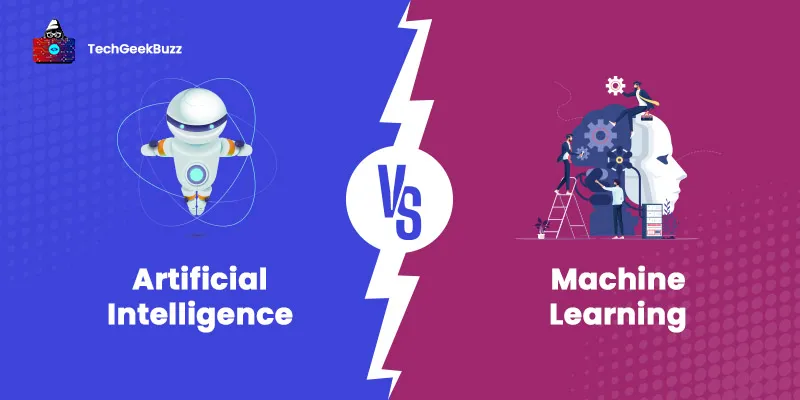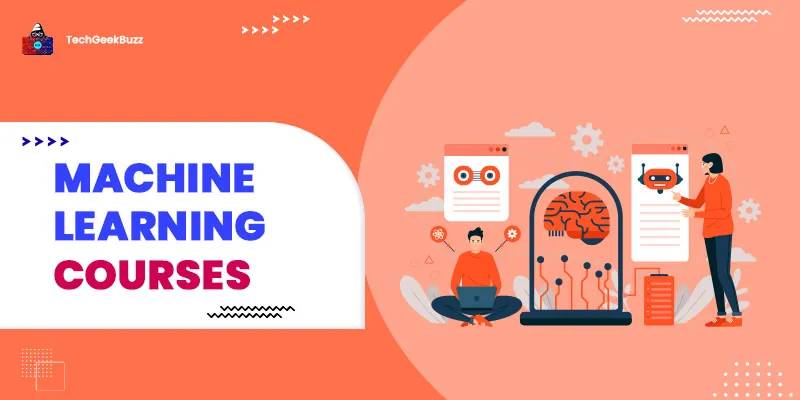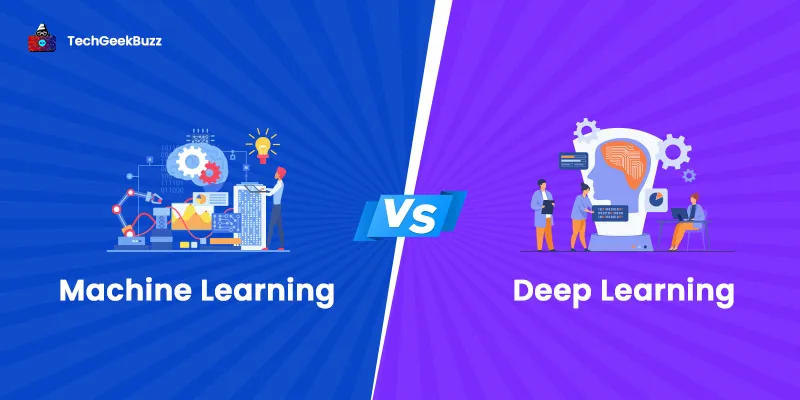Artificial intelligence (AI) and machine learning (ML) are two revolutionary technologies of this modern world that have made human life more convenient than ever before. Companies are leveraging these technologies to provide innovative solutions to their customers and automate their business processes. Some popular creations developed using AI and ML are self-driving cars, digital assistants, and recommendation engines.
People often use the terms artificial intelligence and machine learning interchangeably. However, machine learning is the subset of artificial intelligence. These technologies are extensively used to create intelligent systems capable of performing tasks that require human-like intelligence. Though AI and ML are interrelated to each other, they have a lot of differences.
In artificial intelligence, machines demonstrate intelligence similar to human intelligence. Artificial intelligence is the ability of machines or computer systems to simulate cognitive characteristics of the human mind, such as learning and problem-solving.
On the other hand, machine learning is the branch of AI that enables computer systems to learn from experiences and make accurate predictions without being explicitly programmed to do so.
Through this article, we aim to discuss all the key differences between artificial intelligence and machine learning. Also, we shall make you familiar with the characteristics, advantages, and disadvantages of artificial intelligence as well as machine learning.
So, here it goes!
What is Artificial Intelligence?
Artificial intelligence (AI) means the simulation of human intelligence by machines or computer systems. Alternatively, AI is a branch of computer science that focuses on developing machines or computer systems that can accomplish tasks requiring human intelligence. We can also define AI as Thinking humanly, Thinking rationally, Acting humanly, and Acting rationally.
AI is a broad term that encompasses various fields, such as machine learning, neural networks, computer vision, cognitive computing, and deep learning. There are various types of AI that fall under two major categories, namely capability-based and functionality-based.
The capability-based category groups AI systems based on their ability to think and feel like humans. There are three types of capability-based AI systems, namely weak or narrow AI, general AI, and super AI.
On the flip side, the functionality-based group categorizes AI-enabled systems based on their ability to carry out tasks that require human intelligence. There are four types of functionality-based AIs, namely relative machines, theory of mind, limited memory, and self-awareness.
History
Artificial intelligence is not a new term or technology since it was coined back in 1955 at Dartmouth College. John McCarthy along with Alan Turing, Allen Newell, Herbert A. Simon, and Marvin Minsky are the founders of artificial intelligence.
Later, in 1966, Joseph Weizenbaum created the first chatbot named ELIZA, and in 1972, the first intelligent humanoid robot named WABOT-1 was invented in Japan. The duration from 1974 to 1980 was referred to as the first AI winter duration. The AI winter duration is the duration when scientists experienced a severe shortage of funding from the government.
After the end of the first AI winter duration, ‘Expert Systems’ came into existence. These systems simulated the decision-making ability of humans. The field of AI again experiences the second AI winter duration from 1987 to 1993. Over time, there have been several developments in the field of artificial intelligence, such as IBM Deep Blue, Roomba - a vacuum cleaner, IBM's Watson, Google now, Eugene Goostman - a chatbot, IBM’s project debater, and others, to name a few.
Characteristics of Artificial Intelligence
The following are the main characteristics of artificial intelligence:
- Symbolic Processing: AI-enabled systems process symbols rather than letters or numbers. They process a string of characters that represent real-world entities. We can arrange these symbols in the form of structures, such as hierarchies, networks, or lists.
- Data Ingestion: AI is capable of storing huge amounts of data from heterogeneous sources. It can store structured, semi-structured, and unstructured data.
- Perception: It is the ability to provide insights by analyzing visual images, sounds, and other sensory information, and AI has the ability to do it.
- Fast Decision-Making: AI is capable of making decisions quickly since it is devoid of emotions.
Advantages of Artificial Intelligence
The key advantages of artificial intelligence are as follows:
- AI-enabled systems are the best-fit solutions for situations and environments where human life is more likely to be at risk. A few examples of such situations are space exploration, bomb defusion, workplaces with intense heat, mineral mining, etc.
- Using AI-enabled systems results in the reduction of errors while solving any complex problems that require complex calculations. In addition, you get results with maximum accuracy and precision.
- Unlike humans, AI-enabled systems can work continuously without any breaks. They can even manage tedious and repetitive tasks effectively.
- Since AI-powered machines are devoid of emotions, have no biased views, and are highly practical, they make more informed and precise decisions.
Disadvantages of Artificial Intelligence
The following are significant disadvantages of artificial intelligence:
- High cost is one of the most significant drawbacks of artificial intelligence. In addition, it requires huge amounts of resources and plenty of time to build AI-powered systems for a specific purpose.
- AI is not creative, i.e., it does not think creatively. Instead, it just works as we instruct it to do.
- Many industries, like manufacturing and transportation, are employing robots for tedious tasks, which results in unemployment.
When to Choose Artificial Intelligence?
When you need to build an intelligent system that can perform a specific task by simulating human intelligence, you can opt for artificial intelligence over machine learning. Robots are the best example of AI. They perform specific tasks for which they have been programmed.
What is Machine Learning?
Machine learning is a subset or branch of artificial intelligence that focuses on leveraging data and algorithms to mimic the way humans learn and make predictions. It provides the ability for machines to learn and improve from their experiences without any human intervention. Machine learning algorithms use previous or historical data as input to make new predictions.
ML plays a crucial role in businesses since they entirely rely on data and ML has the capability to make the most out of that data. Machine learning models can analyze huge amounts of data and uncover hidden patterns and trends from it, thus helping businesses make more actionable decisions.
There are four types of machine learning, namely, supervised, unsupervised, semi-supervised, and reinforcement learning, categorized based on their way of learning. Let us take a quick look at each of these types of machine learning.
- Supervised: Supervised machine learning involves training machines with labeled data sets. Here, labeled data sets imply input tagged with its corresponding output. These labeled data sets act as a supervisor or teacher for the machine. Based on these labeled data sets (inputs and outputs), the machine predicts the output for the new data set.
- Unsupervised: Unsupervised machine learning involves training machines with unlabeled data sets. Unlike supervised learning, we only provide inputs to the machine, and it categorizes or sorts that data based on patterns, similarities, and differences.
- Semi-supervised: This type of machine learning combines supervised and unsupervised learning. It works with a few labeled datasets and majorly with unlabeled datasets.
- Reinforcement learning: This type of machine learning works on a feedback-based process. In reinforcement learning, an AI agent carries out actions in an environment and behaves according to feedback it gets from those actions.
History
Arthur Samuel first introduced the term machine learning in 1959. At that time, machine learning was also referred to as self-teaching computers. Nilsson’s book on Learning Machines became the representative book for machine learning research that explored dealing with machine learning for pattern classification.
In 1981, a report was published that explored using teaching methods so that neural networks can recognize 40 characters from a computer terminal. In the years thereafter, the field of machine learning evolved significantly with innovations such as self-driving vehicles, traffic prediction, product suggestions, medical diagnostics, and many more.
Characteristics of Machine Learning
The following are the primary characteristics of machine learning:
- Automation: Machine learning automates repetitive tasks, and hence, increases productivity.
- Accurate Data Analysis : Machine learning can produce accurate results of data analysis. In addition, it can analyze colossal amounts of data in less time and generate accurate results.
- Automated Data Visualization: Machine learning provides various data visualization tools and platforms to produce detailed snippets of data, thus helping businesses make more informed decisions.
Advantages of Machine Learning
Some remarkable benefits of machine learning are as follows:
- Machine learning is capable of analyzing vast amounts of data and uncovering hidden patterns and trends from it.
- It has the ability to learn on its own from historical data or experiences and make accurate predictions.
- Since machine learning algorithms gain experience, they keep on improving their efficiency and accuracy. Therefore, continuous improvement is one of the significant advantages of ML.
- Machine learning algorithms are capable of handling multi-dimensional and multi-variety data.
Disadvantages of Machine Learning
The following are some drawbacks of machine learning:
- It requires a lot of time for ML algorithms to learn and develop to fulfill a specific purpose with maximum accuracy.
- It becomes very challenging to interpret results generated by ML algorithms.
- ML algorithms learn from massive data sets. These datasets should be of good quality and unbiased. In addition, you may sometimes have to wait for new data to be generated.
When to Choose Machine Learning?
When you want to create an intelligent machine that can think and learn from historical data or experiences and does not require human intervention, you can prefer machine learning over artificial intelligence. One of the best examples of machine learning is product recommendation engines. These engines track your purchase history and recommend products accordingly. They do it on their own without any human intervention.
Artificial Intelligence vs Machine Learning: Head-to-Head Comparison
The following table draws all the key differences between artificial intelligence and machine learning:
| Artificial Intelligence (AI) | Machine Learning (ML) |
| Artificial intelligence is a technology that allows machines or computer systems to imitate human intelligence. | Machine learning is a subset of AI that enables computers or machines to learn from their experiences or historical data and make accurate predictions without any human intervention. |
| The primary objective of AI is to build systems that can think like humans and solve complex problems. | The principle goal of ML is to build machines so that they can learn on their own from previous data and predict the correct output when an input is provided. |
| In artificial intelligence, we develop machines to perform tasks that require human intelligence. | In machine learning, we provide data to machines to train them and produce accurate results for the given input. |
| Artificial intelligence is a broad term that encompasses machine learning, computer vision, deep learning, cognitive computing, and neural network. | Machine learning is the subset of artificial intelligence. |
| AI has a wide range of scope. | ML has a limited scope than AI. |
| Artificial intelligence works well with all types of data, i.e., structured, semi-structured, and unstructured. | Machine learning works well with structured and semi-structured data. |
| Popular applications of AI are chatbots, intelligent humanoid robots, and AI-powered assistants. | Popular applications of ML are self-driving cars, recommendation engines, speech recognition, and image recognition. |
Which One is Better: Artificial Intelligence or Machine Learning?
Both AI and ML are trending technologies and are interrelated. The primary difference between AI and ML is that AI involves the development of systems that simulate human intelligence. In contrast, ML focuses on teaching machines by providing data to produce accurate results without any human intervention.
It would not be appropriate to ask which technology is better AI or ML. The choice between AI and ML entirely depends on the task you need to accomplish. AI is an appropriate choice for big data computing, whereas choosing machine learning would be ideal for predictive analysis.
Conclusion
The primary objective of artificial intelligence is to solve complex problems by simulating human intelligence. On the contrary, machine learning’s goal is to enable systems to learn from experiences and improve the accuracy of their predictions. Since machine learning is a subset of artificial intelligence, these technologies complement each other to generate high-quality and precise results.
We hope this article helped you gain enough clarity on the differences between artificial intelligence and machine learning. Also, if you have any queries regarding this article, you can share them with us in the comments section below.
Frequently Asked Questions
1. How are AI and ML connected?
Artificial intelligence and machine learning are closely connected to each other. Artificial intelligence is an umbrella term that encompasses various fields, including machine learning, computer vision, neural networks, deep learning, and cognitive computing. Therefore, machine learning is the subset of artificial intelligence.
2. What are the few common examples of artificial intelligence and machine learning?
The following are a few common examples of artificial intelligence:
- Chatbots
- Natural Language Processing (NLP) tools
- Digital Assistants
- Robots
The following are the common examples of machine learning:
- Self-driving cars
- Traffic prediction
- Recommendation engines
- Image and speech recognition
- Video Surveillance
3. What is the popular programming language for machine learning?
Since machine learning works with large amounts of data, Python and R are the popular programming languages for machine learning. R is a programming language for statistical computing and graphics, and it is popular among data scientists and data analysts. On the other hand, TensorFlow, one of the most prominent machine learning libraries, is written in Python.
People are also reading:
- Machine Learning vs Deep Learning
- Types of Machine Learning
- What is Reinforcement Learning
- Supervised vs Unsupervised Learning
- AI vs ML vs Deep Learning
- Data Science vs Machine Learning
- Types of Artificial Intelligence
- Benefits of Artificial Intelligence
- Artificial Intelligence Technologies
- Data Science vs Artificial Intelligence




